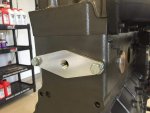IT'S ALIVE!!!!
Well, it was actually alive about three weeks ago but I've been too busy to sit down and post about it.
Got it all back together and started without much trouble, but by chance just happened to discover something that
MIGHT have been the cause of the whole issue...
After I got it started I let it sit and idle for a few minutes to warm up and seat things in. While this was happening, I started wondering if the rockers were getting oil because of the aforementioned issue with the top of the valve where the rocker rides being worn. I took the oil fill cap off and watched the valves I could see, and it didn't look like they were getting any oil. I wasn't sure how much oil I was suppose to see, but I didn't see any. I let it idle for a few more minutes and checked again but still didn't see any oil.
I went over to another deuce I have and started it up and looked in the oil fill, and those rockers started getting oil in about 30 seconds, so I knew something was wrong...
I took the valve covers back off and looked things over, but didn't see anything obviously wrong. I started it back up, climbed up to look at the valves, and saw oil spraying all over the firewall! I jumped down and shut it off as quick as I could and started looking for the source...
Turns out the plug in the end of the rocker tube closest to the firewall was missing! I thought maybe it had just come out but I couldn't find it anywhere.
After taking the rear rocker assembly back off and looking things over very closely, I think that it's been missing for quite awhile, and that the valvetrain has been running without oil! Several of the valve stem ends have abnormal wear, but nothing seemed to be worn too excessively and the valves adjusted fine.


The end of the rocker tube was 3/4" ID so I got some steel 3/4" freeze plugs from the local auto parts store. (That was an adventure in itself...) When I put a plug back in, it was barely even snug in the rocker tube. I'm guessing that was due to the tube being machined a little too big from the factory and that's why the original plug came out. Since the first plug was already in, I swedged out another plug and drove it in behind the first one.


I put everything back together and ran it for a bit with the valve covers off and everything seemed to be getting oil.
So, Here's a theory... Please let me know y'all's thoughts on it...
It's my understanding that the rockers are fed oil from the rear of the rear head.

If that's the case, does that oil passage happen to be fed from the same oil passage that feeds the oil nozzle for the #6 piston?
If so, the passage to the rockers free-flowing oil could have reduced the pressure to the #6 nozzle.
If the #6 nozzle doesn't have enough pressure, it can't adequately cool the #6 piston.
Without enough oil to cool it, the #6 piston gets hot enough to melt slightly, and the back of #6 cylinder gets hot enough to cause a crack.
Possible? Thoughts?










































